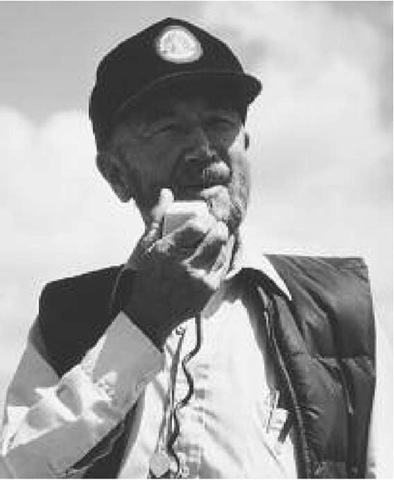(1912-1991) American Paleontologist
Preston Cloud was an outstanding evolutionary paleontologist, biogeologist, and humanist who is best known for several popular science books, his stance against Creationism in public schools, and his dire warnings about overpopulation. Cloud was one of the founders and leaders in the burgeoning field of Precambrian Earth history. He employed a holistic approach to understanding the first 85 percent of Earth history. He developed the idea that periodic radiative explosions of life and especially metazoans were the result of evolutionary opportunism rather than an incomplete record. They reflected the availability of new ecological niches and conditions. Metazoans evolved as the result of the availability of free oxygen which resulted in complex cells. Cloud emphasized complex interrelations through the whole 4.5 billion years. His depth of investigation gave him a special appreciation of the place of humankind within this evolving environment. This deep understanding led him to write and assemble several popular science books on the evolving Earth, including Adventures in Earth Science, Cosmos, Earth and Man and Oasis in Space: Earth History from the Beginning. From this unique vantage, Preston Cloud was able to judge the condition of the Earth within an historical perspective of planetary dimensions. He was successful in warning the public of the dangers of the rapidly increasing population and the steadily decreasing availability of natural resources, a revelation that Cloud made. This warning has been taken up by many environmental groups worldwide as a result and is recognized as our most pressing problem. He was also instrumental in bringing this potentially calamitous situation to the attention of the National Research Council and the National Academy of Sciences, which also took up the cause.
Other areas that Preston Cloud mastered included the origin of carbonate atolls in the Pacific Ocean and the interplay of biological and geological processes in their formation. This theme of biogeology would recur throughout his research efforts whether regarding the evolution of bra-chiopods or the biostratigraphy of carbonate platforms. He was equally skilled in the biostratigraphy of clastic environments as well. Cloud was well known for his ability to adapt his research to take advantage of research opportunities and to seek out projects with the greatest potential.
Preston Cloud was born on September 26, 1912, in West Upton, Massachusetts. His father was an engineer draftsman who traveled constantly. The family moved to Waynesboro, Pennsylvania, in the late 1920s. In 1929, he graduated from Waynesboro High School. The United States was amid the Great Depression in 1930, so Cloud decided to join in the U.S. Navy. When he was discharged in 1933 in California, he hiked his way back to the East Coast. Money was still tight and he was fortunate enough to find enough money to pay for his first semester at George Washington University in Washington, D.C. A mentor, Ray Bassler, was a curator of paleontology at the National Museum and employed Cloud to assist him. Cloud completed his bachelor of science degree in 1938. He enrolled at Yale University, Connecticut, and earned a Ph.D. in paleontology/geology in 1942. He worked with CARL O. DUNBAR.
He was an instructor at the Missouri School of Mines in 1940, and then returned to Yale University as a postdoctoral fellow. In 1941, Cloud joined the U.S. Geological Survey to study manganese deposits in Maine for the World War II mineral exploration program. The next year, he was director of the Alabama Bauxite Project. In 1943, Cloud joined the Texas Bureau of Economic Geology in the Ellenburger Project to study the stratigraphy and sedimentology of the Ellenburger carbonate complex. In 1946, Cloud accepted a position as a professor of invertebrate paleontology at Harvard University, Massachusetts. However, due to a lack of support to expand the teaching and research areas, he returned to the U.S. Geological Survey in 1949. Shortly thereafter he became chief of the Branch of Paleontology and Stratigraphy. He increased the staff from 15 to almost 60 geologists and organized the first two marine biology programs.
In 1961, Preston Cloud accepted a faculty position at the University of Minnesota as a professor of geology, chairman of the Department of Geology and Geophysics, and head of the School of Earth Sciences. In 1965, he decided to take a professorship at the University of California, Los Angeles, but finally settled down permanently at the University of California campus at Santa Barbara in 1968. In 1974, he convinced the head of the U.S. Geological Survey, Vince McKelvey, to build a laboratory at Santa Barbara for the study of early organisms and to rehire Cloud to run it. He officially retired in 1979, but remained active throughout the rest of his life. He was a Luce Professor of Cosmology at Mount Holyoke College, Massachusetts, and a Queen Elizabeth II Senior Fellow at Canberra University, Australia. Preston Cloud died on January 16, 1991, of Lou Gehrig’s disease. Preston Cloud had three marriages during his life, first to Mildred Porter, from 1940 to 1949; second to Francis Webster from 1951 to 1965; and finally to Janice Gibson in 1972. Cloud and Francis Webster had three children.
Preston Cloud was the author of some 200 publications ranging from scientific papers in international volumes and journals to governmental reports to popular science writing. In recognition of his many contributions, Preston Cloud received numerous honors and awards. He was a member of the National Academy of Sciences, the American Academy of Arts and Sciences, and the Polish Academy of Sciences. He was awarded the Wal-cott Medal from the National Academy of Sciences, the Penrose Medal from the Geological Society of America, the Paleontological Society Medal (United States), the L.W. Cross Medal from the American Philosophical Society, the A. C. Morrison Award from the New York Academy of Sciences, the Rockefeller Public Service Award, and the Distinguished Service Award and Gold Medal from the U.S. Department of the Interior.
Preston Cloud leads a field trip in California in 1982

